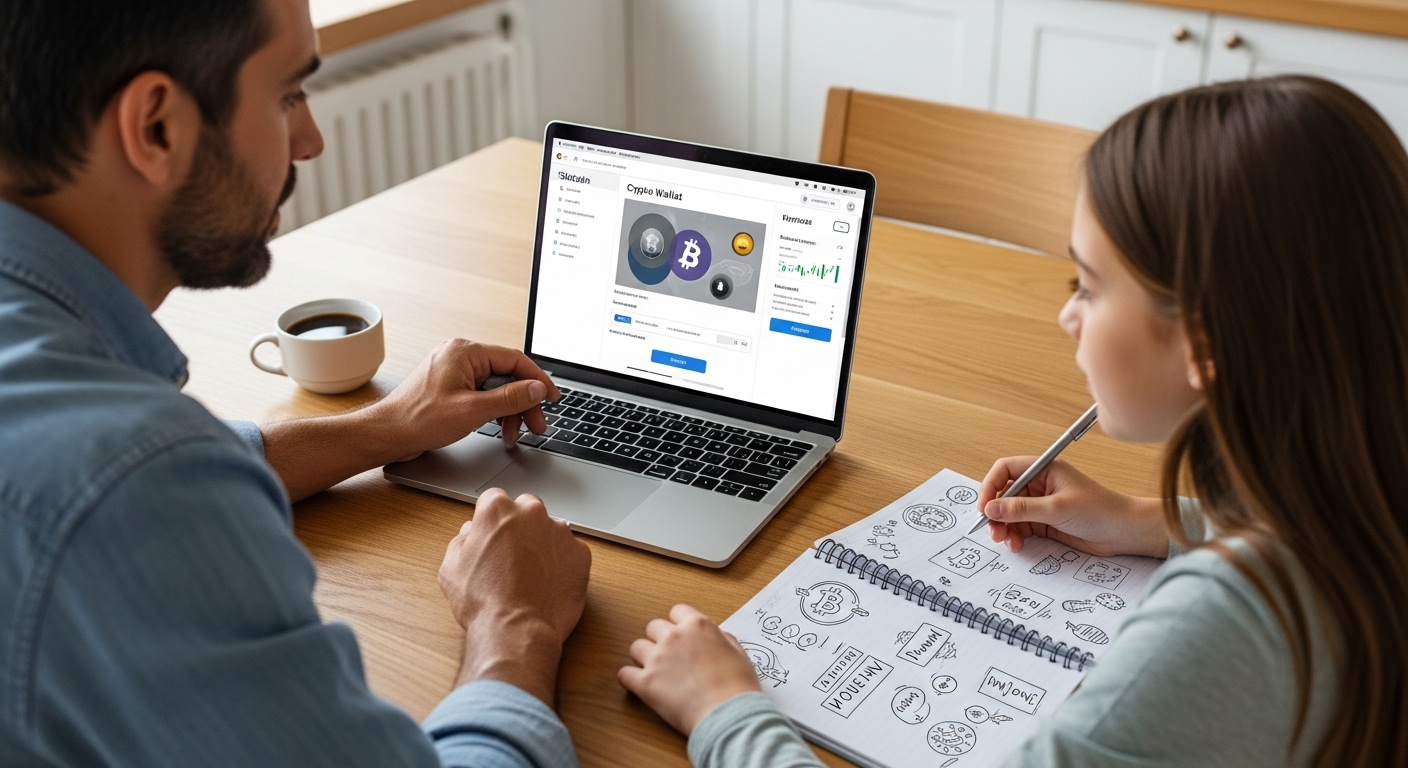Crypto is reshaping how money works, and kids are watching. Smart parents want their children to get a head start without taking on adult-level risk. A custodial crypto account for minor gives you that balance, pairing long-term investing with hands-on learning.
Here is the simple version. A custodial crypto account is an investment account where an adult manages crypto on behalf of a child under 18, then transfers control when the child reaches the age of majority.
You hold the keys, set rules, fund the account, and teach responsible habits while assets grow.
Why now? The total crypto market topped $4 trillion in October 2025, and this momentum is drawing families into structured, safer ways to participate.
For entrepreneurs raising the next generation of builders, this is a practical way to teach budgeting, risk, wallets, and compounding. It is education with real stakes, wrapped in guardrails.
The benefits are clear. You maintain control, add security, and introduce money lessons early. Kids learn with real assets, not just theory, and you can start with small, recurring buys to reinforce discipline.
We will keep it practical. You will see how these accounts work, what to consider legally, and where tax rules come in.
You will compare platform options, fees, and coin access, then review risks and smart safeguards. You will get a step-by-step setup checklist, age-based teaching tips, and a simple plan to turn a custodial crypto account for minor into a lasting financial education.
Check out our guide on How to Connect with Experts for Your Crypto License to improve your skills.
Understanding Custodial Crypto Accounts for Minors

A custodial crypto account for minor flips the script on control, access, and responsibility. You, the adult, hold the keys and guide the journey until your child reaches legal age.
The upside is clear, your child learns with training wheels, while you prevent costly mistakes.
Think of it like a secured sandbox. The child sees and learns, you approve and protect. That structure is the difference between curiosity and chaos.
Key Differences from Adult Crypto Accounts
Adult accounts are simple, full control from day one. Custodial setups add layers that protect a young investor and keep you in charge.
Here is what changes when the account belongs to a minor:
-
Ownership and control: You own and manage the assets until the age of majority. The child is the beneficiary, not the account owner.
-
Legal transfer: Control shifts at 18 or 21, based on your state or country. Until then, you must authorize actions.
-
KYC and compliance: The adult completes identity checks and signs the user agreement. The minor does not pass KYC alone.
-
Spending and withdrawals: Adults set permissions, limits, and approvals. Kids can view balances and propose actions if the app supports it.
-
Security: You manage passwords, 2FA, recovery phrases, and device approvals. The goal is to block irreversible errors and scams.
-
Education-first interfaces: Many kid-focused apps add explainers, quizzes, and simulated trades. That keeps learning ahead of risk.
-
Funding rules: Adults handle deposits, recurring buys, and rebalancing. Minors do not connect bank accounts directly.
-
Tax reporting: You handle tax forms and record keeping. Gains, gifts, and cost basis need adult oversight.
Why this matters: crypto is fast and unforgiving. A custodial design slows it down so your child can learn without burning capital.
A quick example to make this concrete:
- On a major exchange like Coinbase, standard policy is adult accounts only. If a custodial flow is supported in the future, it would likely work like this, the parent opens an account, passes KYC, enables a supervised sub-account, and sets permissions for viewing, buying small amounts, or using “learn” modules. The parent would retain withdrawal control and custody of keys until the child reaches legal age.
A few parent-managed features to prioritize:
-
Spend controls: Daily or monthly limits, approval prompts, and lockable withdrawals.
-
Guardrails: Allowlists for coins, no high-risk tokens, and warnings for volatile assets.
-
Education tools: In-app lessons, goal tracking, and mock portfolios to practice before buying.
-
Alerts: Real-time notifications for login attempts, transfers, or price swings.
Bottom line, a custodial crypto account for minor prioritizes guidance over speed. You reduce risk, keep learning front and center, and hand over real responsibility when your child is ready.
Top Benefits of a Custodial Crypto Account for Your Child’s Future

A custodial crypto account for minor does more than hold coins. It turns money into a hands-on classroom where your child learns to save, invest, and think long term.
With you as the guide, your child practices real decision making without taking on adult-level risk. That is how confidence and discipline grow. Discover How Investors’ Attention Affects Bitcoin Market Changes by reading the guide given.
How It Builds Financial Smarts Early On
When kids can see their money move, the lessons stick. A custodial crypto account for minor makes abstract ideas like compounding, volatility, and diversification visible in a simple dashboard.
Here is what children pick up fast:
-
Market basics: Prices move. News matters. Trends shift. They learn to read charts, spot patterns, and avoid impulse buys.
-
Patience: Watching a chart day to day teaches that gains come over months, not minutes.
-
Risk awareness: Red days happen. Kids learn to sit tight, not panic sell.
Gamified learning keeps it fun without fluff. Many kid-friendly apps add quizzes, badges, and progress trackers that reward good habits like setting goals, sticking to DCA, and reviewing performance monthly. The game is simple, build streaks, not bets.
A simple way to start is with a small, real stake. Try $50 in Ethereum and use it as a weekly lesson. Have your child log the buy date, the cost basis, and the current value on the same day each week.
Plot the changes in a shared spreadsheet. The chart becomes a story, dips test patience, and green weeks reinforce sticking to a plan.
For small business parents, tie lessons to what you do every day:
-
Inventory analogy: Prices go up and down like your wholesale costs. You still reorder and plan for seasons.
-
Marketing spend: You do not judge an ad by one day. You look at trends and ROI over time.
-
Cash flow: Teach your child to leave a buffer. Keep some stablecoins as the rainy-day fund, just like your operating reserve.
Try this three-step weekly routine that fits into a busy schedule:
-
Review the portfolio together for five minutes. Highlight one key change and the why behind it.
-
Ask your child to explain one term back to you, like cost basis, DCA, or volatility.
-
Log a small recurring buy, even five dollars, to reinforce consistency over timing.
Use stories to make lessons relatable. A parent who runs a bakery can frame Ethereum as a long-term oven upgrade. You would not cancel the order because flour prices spike for a week. You stay the course because the upgrade pays off over years.
Practical guardrails help kids learn safely:
-
Set an allowlist of coins so they avoid hype tokens.
-
Turn on alerts for price swings, but review only once a week.
-
Use clear goals, like saving toward a summer camp or a starter laptop.
Key takeaway, real ownership makes learning real. A custodial crypto account for minor gives your child skin in the game, with you steering the rules. Start small, track progress, and let time do the heavy lifting.
How to Choose and Set Up the Best Custodial Crypto Platform

Setting up a custodial crypto account for minor is part product choice, part process. Your goal is simple, safe access, low fees on small buys, and clear parent controls.
Start with a shortlist, compare fees, lock in security, and document how you will transfer assets when your child reaches legal age.
Popular Platforms for Kids’ Crypto in 2025
You want practical, low-friction tools that fit a small budget. The options below cover simple kid-first apps, mainstream exchanges managed by parents, and Bitcoin-only routes that keep things tight and affordable.
| Platform | Best For | Supported Coins | Parent Controls | Cost Snapshot |
|---|---|---|---|---|
| EarlyBird | Simple, education-first custodial wallets | Major coins via partner custody | Adult-owned account, beneficiary view, gifting links | Subscription model plus trading spread; good for small recurring buys |
| Coinbase (parent-managed) | Broad coin access with parent as the account owner | Wide list of assets and stablecoins | Full adult control, optional view-only access for learning | Trading fee plus spread; free recurring buys, standard exchange costs |
| Cash App (with parental approval) | Bitcoin-only, easy funding from a debit card | Bitcoin only | Spending limits, activity notifications, teen permissions | Simple fee on buys plus spread; strong for micro-purchases |
| Bitpanda (family use) | All-in-one investing with crypto under adult control | Major coins and tokens | Adult KYC, account-level controls, clear export tools | Variable spread-based pricing; transparent quotes before buy |
Notes to compare quickly:
-
For the smallest budgets, focus on platforms that support micro-buys, recurring purchases, and low or transparent spreads.
-
Bitcoin-only setups like Cash App reduce choice, but simplify risk and taxes.
-
Parent-managed accounts on mainstream exchanges keep costs predictable, while kid-first apps add gifting and education features.
How to choose in five minutes:
-
Define scope. Bitcoin-only for simplicity, or a short list like BTC and ETH.
-
Estimate monthly buys. Under $50 favors low-spread, micro-friendly tools.
-
Check controls. Look for spending limits, view-only access, and alerts.
-
Verify fees. You want clear quotes before buy, low deposit friction, and no lock-in.
-
Confirm transfer path. Can you export to another wallet later with a clean cost basis?
Two quick examples:
-
You want a simple, gift-friendly setup. Pick EarlyBird, set $10 weekly buys into BTC and ETH, enable alerts, and share view access with your child.
-
You want broad access but full adult control. Use Coinbase in your name, run recurring buys, and let your child review a read-only dashboard weekly.
Pro tip for founders and owners: match buys to your cash flow cycle. If revenue is lumpy, set a modest weekly DCA, then add a manual top-up after strong weeks.
Legal Steps and Common Pitfalls to Avoid
A custodial crypto account for minor must follow clear rules. Keep it simple and keep it legal.
Key legal checks:
-
Verify platform compliance. Choose providers with US KYC/AML, clear terms, and export options.
-
Use your legal name for KYC. Minors cannot pass KYC alone; the adult owns and administers the account.
-
Document the beneficiary. If the platform supports a custodial or beneficiary field, fill it in and save a copy.
-
Save a transfer plan. Note how you will hand off control at 18 or 21, based on your state.
-
Keep records. Store cost basis, dates, and transfers. Download statements quarterly.
Smart setup process:
-
Open the adult account, complete KYC, enable 2FA, and add a hardware security key.
-
Create a kid folder. Store seed phrases offline, plus printed recovery instructions in a sealed envelope.
-
Set a coin allowlist. Limit buys to BTC and ETH at first, add stablecoins later.
-
Schedule small recurring buys. Consistency beats timing, especially for kids.
-
Review quarterly. Reconfirm settings, export a CSV, and update your transfer notes.
Common pitfalls to avoid:
-
No asset transfer plan. Without a simple letter of direction, you risk confusion later. Write a one-page note with the account list, where keys are stored, and when to transfer.
-
Ignoring taxes. Selling or swapping triggers capital gains. Track cost basis and holding periods. For small accounts, long-term holds reduce paperwork and surprise taxes.
-
Blurry ownership. Do not mix your trading stack with your child’s. Keep a separate account or tag each buy for the child.
-
Weak security. Skip SMS-only 2FA. Use an authenticator app, device approvals, and a hardware key for withdrawals.
-
Illiquid coins. Avoid obscure tokens. Focus on assets with strong liquidity and clear reporting.
Helpful tax tips for busy entrepreneurs:
-
Use long-term holds. Keep positions for more than one year to help rates.
-
Automate logs. Export CSVs after each quarter and store them with your bookkeeping files.
-
Plan small rebalances. If you must sell, group trades to reduce record sprawl and round-trip fees.
Bottom line, you need guardrails, not guesswork. Pick a platform that fits your budget, lock down controls and security, then document how the custodial crypto account for minor will pass to your child when the time comes.
Risks and Tips for Safe Management of Your Child’s Crypto
A custodial crypto account for minor puts you in control, but it does not remove risk. Your job is to filter noise, build guardrails, and teach habits that stick. Think of it like a seatbelt and a speed limit, both matter.
Common Risks Parents Miss
Crypto risk shows up in more ways than price moves. These are the gotchas that trip families up.
-
Volatility risk: Fast price swings can shake confidence and trigger bad decisions.
-
Account security risk: Phishing, SIM swaps, and weak 2FA expose funds.
-
Custody and access risk: Lost devices, missing seed phrases, or a single point of failure.
-
Scam risk: Fake airdrops, giveaway scams, and impostor support chats.
-
Regulatory and tax risk: Age limits, changing state rules, and taxable events on swaps.
Quick fixes beat complex plans. Aim for simple rules that hold up on busy weeks.
Security Best Practices That Actually Work
Security is a habit, not a feature. Set these once, then review quarterly.
-
Turn on authenticator app 2FA for logins and withdrawals, avoid SMS.
-
Add a hardware security key for the parent account that controls custody.
-
Use an allowlist of wallet addresses for withdrawals if the platform supports it.
-
Lock down devices, unique email, strong password, and no reuse across apps.
-
Store recovery phrases offline in two locations, sealed and labeled with simple instructions.
-
Create read-only access for your child so they learn without the ability to move funds.
Pro move, run a 10-minute family phishing drill. Show a fake support DM, a copycat domain, and a suspicious QR code. Teach your child to pause and ask you first.
Smart Trading and Allocation Rules
Your plan should be boring by design. Boring plans survive red days.
-
Start with a core allocation to BTC and ETH, then reevaluate after six months.
-
Use Dollar-Cost Averaging (DCA) with small weekly buys to reduce timing stress.
-
Keep 10–20% in stablecoins for teachable moments and spending flexibility.
-
Avoid illiquid tokens and high-fee products that complicate taxes and exits.
-
Rebalance twice a year, not monthly, to reduce churn and simplify recordkeeping.
Example, $10 per week into BTC and ETH, a $50 stablecoin buffer, and one review day every quarter. Simple, repeatable, low drama.
Teaching Responsibility Without Losing Control
You want learning without letting a minor pull every lever. Set clear roles.
-
You approve buys and withdrawals, your child logs notes and learns terms.
-
Use goals your child cares about, like saving for a laptop or camp.
-
Review the portfolio together weekly for five minutes, not every day.
-
Let your child present one insight per month, like a trend or news event, and how it might affect the plan.
Make it a team sport. You run custody, your child runs the journal.
Red Flags and What To Do If Something Goes Wrong
When risk shows up, speed and clarity matter. Here is a simple triage.
-
Unrecognized login or transfer attempt. Freeze withdrawals, rotate passwords, revoke sessions, and recheck 2FA.
-
Suspicious message or link clicked. Disconnect Wi-Fi, run a scan, change passwords on a safe device, and reverify address allowlists.
-
Lost recovery info. If platform-custodied, contact support and update verified info. If self-custodied, follow your printed recovery plan immediately.
-
Tax surprise after a swap. Export CSVs, document cost basis, and plan longer holds to avoid repeat pain.
Keep a one-page action sheet in your kid folder with support contacts, device serial numbers, and the step order to recover.
Risk-to-Action Cheatsheet
Use this quick map during setup and reviews.
| Risk | Parent Move |
|---|---|
| Price swings | DCA, long holding periods, semiannual rebalances |
| Phishing and SIM swaps | Authenticator 2FA, hardware key, no-SMS policy |
| Lost access | Dual offline seed storage, recovery drill, read-only child login |
| Scams and hype | Coin allowlist, no DMs policy, review new assets quarterly |
| Regulatory and tax | Keep adult ownership, export statements quarterly, minimize swaps |
Your edge is structure. A custodial crypto account for minor works best when you pair simple security habits with slow, steady investing. Keep controls tight, coaching consistent, and your child will learn without taking on adult-level risk.
Conclusion
A custodial crypto account for minor gives parents control while kids learn with real stakes. You set the guardrails, fund small recurring buys, and document transfer plans, so education comes first and mistakes stay contained.
The payoff is practical money skills, better judgment, and a calm approach to risk.
The playbook is simple, not easy. Define the account’s purpose, pick a platform that fits small budgets and strong controls, secure it with 2FA and hardware keys, and keep clean records for taxes.
Teach patience, stick to BTC and ETH early on, schedule reviews, and avoid hype coins that add cost and stress.
If you are ready to act, start small with a platform like EarlyBird, run $5 to $10 weekly buys, and make it a five-minute family habit.
This helps kids build the mindset they will need in business and tech, discipline, planning, and long-term thinking. Talk to your financial advisor first.
Thanks for reading. Your next step is simple, pick your platform, set a recurring buy, and put a date on the calendar to review together.
The right structure today can set your child up for confident investing tomorrow, and a smarter path into entrepreneurship later. Explore the relationship between Cryptocurrency and the COVID-19 Pandemic.

I am Adeyemi Adetilewa, a content marketing strategist helping B2B SaaS brands grow their organic traffic, improve search visibility, and attract qualified leads through data-driven, search-optimized content. My work is trusted by the Huffington Post, The Good Men Project, Addicted2Success, Hackernoon, and other publications.
